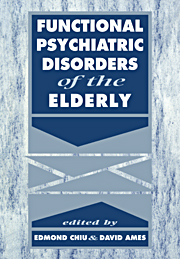Book contents
- Frontmatter
- Contents
- List of contributors
- Preface
- Introduction – A personal note
- Acknowledgement
- Part 1 Classification
- Part 2 General epidemiology
- Part 3 Neuroses
- Part 4 Affective disorders
- 7 The epidemiology of affective disorders in old age
- 8 The outcome of depressive illness in old age
- 9 Pseudodementia in geriatric depression
- 10 Depression in nursing and residential homes
- 11 Depression in primary care settings
- 12 Treatment of depression in the elderly
- 13 Mania in late life: conceptual and clinical issues
- 14 Suicide in the elderly
- Part 5 Psychosexual disorders
- Part 6 Substance use and abuse
- Part 7 Schizophrenia and related psychoses
- Part 8 Psychological, biological and medical issues
- Part 9 Treatment methods
- Part 10 Conclusion
- Index
10 - Depression in nursing and residential homes
from Part 4 - Affective disorders
Published online by Cambridge University Press: 13 November 2009
- Frontmatter
- Contents
- List of contributors
- Preface
- Introduction – A personal note
- Acknowledgement
- Part 1 Classification
- Part 2 General epidemiology
- Part 3 Neuroses
- Part 4 Affective disorders
- 7 The epidemiology of affective disorders in old age
- 8 The outcome of depressive illness in old age
- 9 Pseudodementia in geriatric depression
- 10 Depression in nursing and residential homes
- 11 Depression in primary care settings
- 12 Treatment of depression in the elderly
- 13 Mania in late life: conceptual and clinical issues
- 14 Suicide in the elderly
- Part 5 Psychosexual disorders
- Part 6 Substance use and abuse
- Part 7 Schizophrenia and related psychoses
- Part 8 Psychological, biological and medical issues
- Part 9 Treatment methods
- Part 10 Conclusion
- Index
Summary
Introduction
It has been estimated that 43% of Americans turning 65 in 1990 will enter a ‘nursing home before death (Kemper & Murtaugh, 1991) and that 55 % will stay in such a home for over one year. Although the extent and type of residential and nursing home provision vary extensively between developed countries, increased longevity and rising social mobility mean that in those places where community services to support the old in their own homes do not improve, the demand for places in long-term care is likely to rise. It is probable that factors leading to admission (Loebel et al., 1991b; Ames, 1992a) and the characteristics of the institutions themselves (Godlove, Richard & Rodwell, 1982; Rodwell, 1982; Mann, Graham & Ashby, 1984a; Vousden, 1987; Ames, 1992a) play a significant role in determining rates of mental disorder among inmates of nursing and residential homes. Thus it is appropriate that research on the mental health of the elderly in such homes should be a matter of concern to psychiatrists and others involved with the prevention of disability and the delivery of health care. The rapid growth of the research literature in this field indicates a dawning awareness of these realities.
Although dementia is the commonest psychiatric disorder reported in residential and nursing homes worldwide (Spagnoli et al., 1986; Ineichen, 1990; Jorm & Henderson, 1990; Rovner et al., 1991) depression is common in long-term care institutions for the old too. Other psychiatric disorders have been little studied in these settings.
- Type
- Chapter
- Information
- Functional Psychiatric Disorders of the Elderly , pp. 142 - 162Publisher: Cambridge University PressPrint publication year: 1994
- 6
- Cited by

